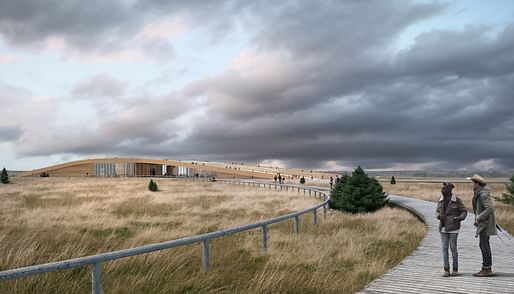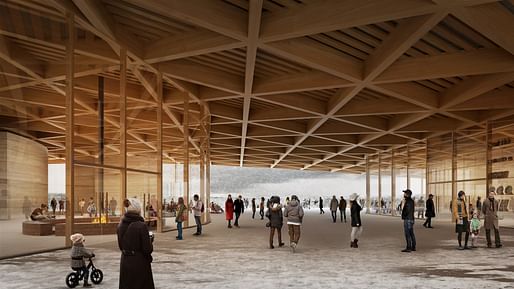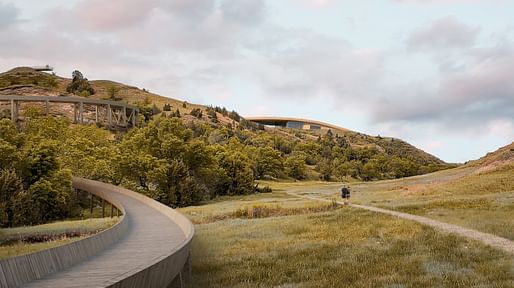
Snøhetta has unveiled their proposal for the Theodore Roosevelt Presidential Library in North Dakota. The firm is competing against Studio Gang and Henning Larsen for the commission.
Snøhetta's proposal is designed as "a journey through a preserved landscape of diverse habitats, punctuated with small pavilions providing spaces for reflection and activity," and is topped by a gently curving roof meant to evoke the rolling hills surrounding the library.


"The Library is the landscape," write the architects, explaining that the building's roof is fully accessible to visitors for day and night occupation. A "generous, covered porch" marks one end of the structure that overlooks nearby valley landscapes while a surrounding Library loop hiking path connects nearby trails and a series of pavilions designed by the architects. The entire ensemble—library, roof, trails, and pavilions—is seen by the designers as one unified, complimentary whole with each component responding to and enriching the others.
"Ranging from contemplative nooks to expansive vistas, these pavilions invite visitors to experience Roosevelt’s trials and triumphs in dialogue with the landscapes that shaped him. The Library is understood to be the buildings, pavilions, paths and landscape," the designers explain.

The trails weave throughout the landscape, bringing visitors in proximity to the site's majestic natural landscapes while also hovering delicately above them and framing views onto the most notable features of the site.

The Library building itself is designed with a light-touch approach, as well, and features design elements that work to shield the structure from prevailing winds and the sun, while the building's energy systems are designed to achieve high levels of efficiency. These arrangements, according to the architects, are meant to make the complex "accessible in all seasons."
4 Comments
Winner
There is so much to be said about TR, up and down, but his experience in North Dakota transcends and is moving, perhaps inspiring.
—Just a few months later, on February 14, 1884, Theodore Roosevelt’s wife, Alice Hathaway Lee, and mother, Mittie Roosevelt, died on the same day in the same house. T.R. was devastated, writing famously in his diary, “The light has gone out of my life.”
—Depressed, T.R. finished up his third term as a New York assemblyman, and fled to the Badlands in western Dakota to mourn and recover. T.R. met people who were not like him. He learned the value of hard work worth doing. He sat under the stars, appreciated nature and loneliness in the vast, open space. He lived the strenuous life, and in doing so found reason to go on living.
—T.R. said, of course, that he never would have been president without his experience in North Dakota. Later, perhaps more significantly, he wrote that if all his memories were to be taken from him, and he was forced only one memory from his incredible life he would choose to remember “my life on the ranch with its experiences close to nature and among the men who lived nearest her.”
From the library site.
This design fits the theme and spirit well. It shows priorities and a certain humility, yet still makes itself known and lifts. It is also a monument that would serve us well today in our troubled and manic times.
this is really nice.. it's good to see that even when a building necessitates being an icon, a firm can treat it with restraint and taste.
This is the best of the three proposals. I hope it is selected, but I'm afraid that this kind of restrained design is not in line with the prevailing taste level in the USA.
Block this user
Are you sure you want to block this user and hide all related comments throughout the site?
Archinect
This is your first comment on Archinect. Your comment will be visible once approved.